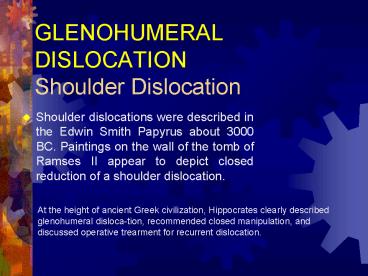GLENOHUMERAL DISLOCATION Shoulder Dislocation - PowerPoint PPT Presentation
1 / 10
Title:
GLENOHUMERAL DISLOCATION Shoulder Dislocation
Description:
At the height of ancient Greek civilization, Hippocrates clearly described ... The heel of the foot is placed against the humeral head in the axilla. ... – PowerPoint PPT presentation
Number of Views:3262
Avg rating:5.0/5.0
Title: GLENOHUMERAL DISLOCATION Shoulder Dislocation
1
GLENOHUMERAL DISLOCATION Shoulder Dislocation
- Shoulder dislocations were described in the Edwin
Smith Papyrus about 3000 BC. Paintings on the
wall of the tomb of Ramses II appear to depict
closed reduction of a shoulder dislocation.
At the height of ancient Greek civilization,
Hippocrates clearly described glenohumeral
disloca-tion, recommended closed manipulation,
and discussed operative trearment for recurrent
dislocation.
2
EpidemioIogic studies
- Hovelius reported that the incidence of shoulder
dislocations between the ages of l8 and 70 years
in Sweden was l.7. - Most studies have noted a 2 to 5 times greater
incidence of dislocations among males compared
with females. - Although they occur at all ages, the greatest
number of initial dislocations occur between ages
l0 and 20 years. - However, fractures, rotator cuff injuries, and
neurovascular injuries are more common in older
individuals.
3
The glenohumeral joint is the most mobile and
most commonly dislocated major joint. The
tremendous range of motion is achieved at the
expense of intrinsic skeletal stability. Kazar
found that 45 of dislocations involve the
shoulder. 86 of shoulder dislocations were
glenohumeral dislocations.
- Normal glenohumeral anatomy
4
Direction of Dislocation Anterior.
- The vast majority of glenohumeral dislocations
are anterior. In Rowe's series, 98 of
dislocations were anterior and 2 were posterior.
- Many references have discussed the different
positions of the humeral head in anterior
dislocahons. - Subcoracoid dis-locations are the most common,
followed by subglenoid, subclaviculap and
intrathoracic. Intrathoracic dislocationsare
exceedingly rare.
5
Anterior Glenohumeral DislocationMECHANIISM OF
INJURY
- 95 of the dislocations were classified as
traumatic, it is very age dependent. In the
younger age groups, athletic injures are common,
such as from athletic trauma or a fall, whereas
in older persons, often the result of falls. - The indirect mechanisms are usually caused by
varying degrees of abduction, extension, and
external rotation forces on the arm. Inferior
dislocation is the result of a hyperabduction
force that levers the proximal humerus against
the acromion and out of the glenoid inferiorly.
6
Mechanism of injury
- B Anterior labral detachment from the glenoid
rim. C Anterior labral datachment in which the
periosteum of the anterior neck of the scapula
remains attached to the labrum. D Disruption of
the glenohumeraI capsule and anterior ligaments
at the humeraI insertion. E Fracture Of the
anterior glenoid rim. F Avulsion Of the great
tuberosity (common in older patients).
G.Posterior capsular disruption and rotator cuff
tear.
7
PATHOLOGY
- Throughout the orthopaedic literature of the 20th
century,there has been discussion about the
"essential lesion" of recurring anterior
glenohumeral dislocation, credited with
identifying the importance of detachment of the
labrum and the anterior gleno-humeral capsule
from the anterior rim of the glenoid.
8
Hippocratic technique
- The heel of the foot is placed against the
humeral head in the axilla. - And longitudinal traction is applied to the arm
- It was predominant 2000 years.
- Traction and leverage
- Less traumatic
9
Kocher maneuver
- The supine position
- Holding the elbow
- Externally rotate humerus
- Neurovascular complications and humeral fractures.
10
Stimson techniqe
- The patient is positioned prone
- The arm is allowed to hang down.
- 10 lb of weight
- Some form of relaxation is usually required.

